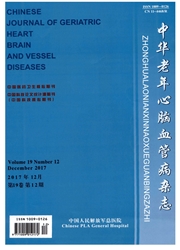

 中文摘要:
中文摘要:
目的探讨颅内动脉瘤破裂的患者预后影响因素。方法回顾性分析576例颅内动脉瘤破裂患者的病历资料,对患者的年龄、性别、入院时有无头痛症状、Hunt-Hess分级、手术时机和手术方式等进行单因素和多因素logistic回归分析,根据格拉斯哥预后评分(GOS)评价影响手术预后的相关因素。结果单因素分析结果显示,患者的年龄、入院时有无头痛症状、Hunt-Hess分级、手术时机和手术方式是影响破裂颅内动脉瘤患者预后的影响因素(P〈0.05,P〈0.01)。多因素logistic回归分析显示,年龄(OR=0.329,95%CI:0.144~0.735,P=0.021)、Hunt-Hess分级(OR=1.358,95%CI:2.531~5.622,P=0.002)、手术时机(OR=1.826,95%CI:1.521~2.103,P=0.019)和手术方式(OR=0.428,95%CI:0.246~0.745,P=0.003)是影响破裂颅内动脉瘤患者预后的独立危险因素。结论准确的病情综合分析、最佳的手术时机和正确的手术方式是提高患者预后的关键。
 英文摘要:
英文摘要:
Objective To study the factors influencing the outcomes in patients with ruptured intracranial aneurysms.Methods Five hundred and eighty patients with ruptured intracranial aneurysms were included in this study.Their clinical data were retrospectively analyzed by univariate and multivariate logistic regression analysis,including age,gender,headache symptoms at admission,Hunt-Hess classification,surgical time and procedure.Related factors influencing the outcomes in patients after operation were assessed according to the GOS.Results Univarite logistic regression analysis showed that age,headache symptoms at admission,Hunt-Hess classification,and surgical time and procedure were the factors influencing the outcomes in patients with ruptured intracranial aneurysms(P〈0.05,P〈0.01).Multivariate logistic regression analysis displayed that age,headache symptoms at admission,Hunt-Hess classification,surgical time and procedure were the independent risk factors for the outcomes in patients with ruptured intracranial aneurysms(OR=0.329,95%CI:0.144-0.735,P=0.021;OR=1.358,95%CI:2.531-5.622,P=0.002;OR=1.826,95%CI:1.521-2.103,P=0.019;OR=0.428,95%CI:0.246-0.745,P=0.003).Conclusion Accurate comprehensive analysis,best operation time and right operation procedure play an important role in improving the outcomes in patients with ruptured intracranial aneurysms.
 同期刊论文项目
同期刊论文项目
 同项目期刊论文
同项目期刊论文
 期刊信息
期刊信息
